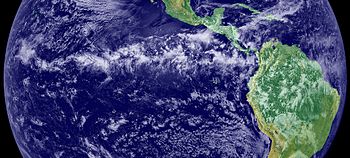Intertropical Convergence Zone
The ITCZ is formed by vertical motion largely appearing as convective activity of thunderstorms driven by solar heating, which effectively draw air in; these are the trade winds.
Rather, it is modulated by a number of regional features such as local atmospheric jets and waves, proximity to the oceans, terrain-induced convective systems, moisture recycling, and spatiotemporal variability of land cover and albedo.
It lies just south of the equator during the Southern Hemisphere warm season, but can be more extratropical in nature, especially east of the International Date Line.
It is considered the largest and most important piece of the ITCZ, and has the least dependence upon heating from a nearby land mass during the summer than any other portion of the monsoon trough.
When ENSO reaches its warm phase, otherwise known as El Niño, the tongue of lowered sea surface temperatures due to upwelling off the South American continent disappears, which causes this convergence zone to vanish as well.
[citation needed] In the Age of Sail, to find oneself becalmed in this region in a hot and muggy climate could mean death when wind was the only effective way to propel ships across the ocean.
[15] Even today, leisure and competitive sailors attempt to cross the zone as quickly as possible as the erratic weather and wind patterns may cause unexpected delays.
[16] The aircraft crashed with no survivors while flying through a series of large ITCZ thunderstorms, and ice forming rapidly on airspeed sensors was the precipitating cause for a cascade of human errors which ultimately doomed the flight.
Atmospheric reanalyses suggest that the ITCZ over the Pacific has narrowed and intensified since at least 1979, in agreement with data collected by satellites and in-situ precipitation measurements.
The IPCC Sixth Assessment Report indicated "medium agreement" from studies regarding the strengthening and tightening of the ITCZ due to anthropogenic climate change.
However, simulations in Coupled Model Intercomparison Project Phase 6 (CMIP6) have shown greater agreement over some regional shifts of the ITCZ in response to anthropogenic climate change, including a northward displacement over the Indian Ocean and eastern Africa and a southward displacement over the eastern Pacific and Atlantic oceans.
[20] The doldrums are notably described in Samuel Taylor Coleridge's poem The Rime of the Ancient Mariner (1798) and also provide a metaphor for the initial state of boredom and indifference of Milo, the child hero of Norton Juster's classic 1961 children's novel The Phantom Tollbooth.





